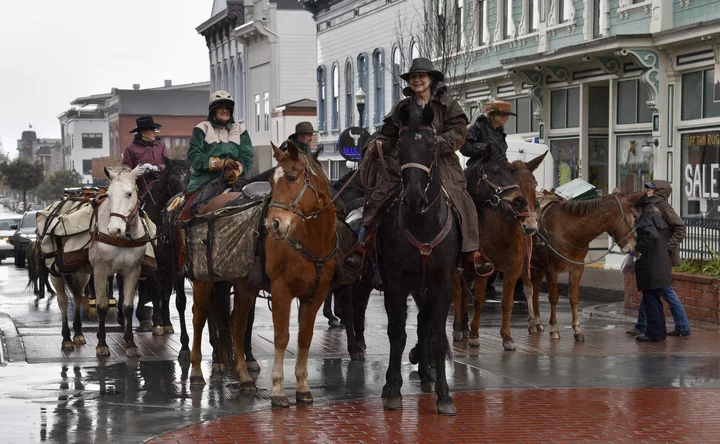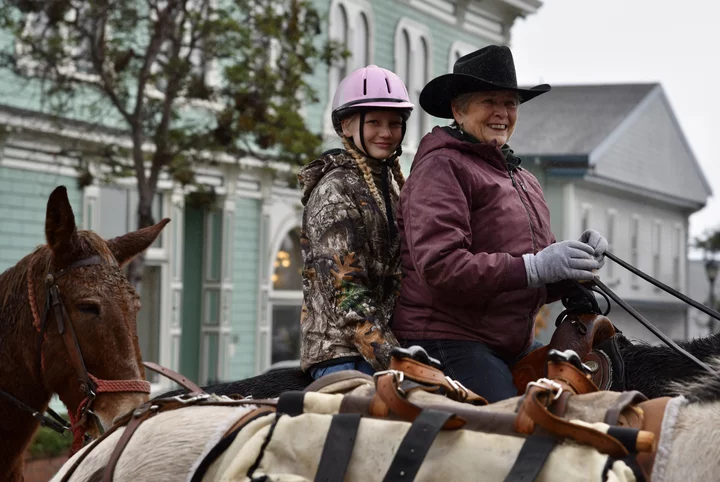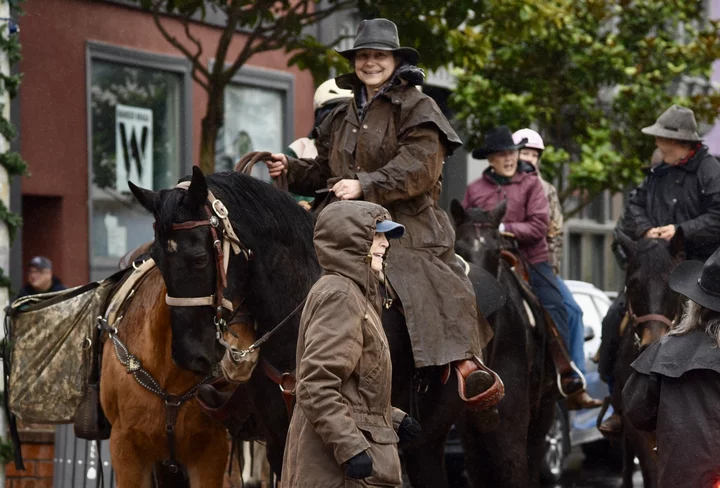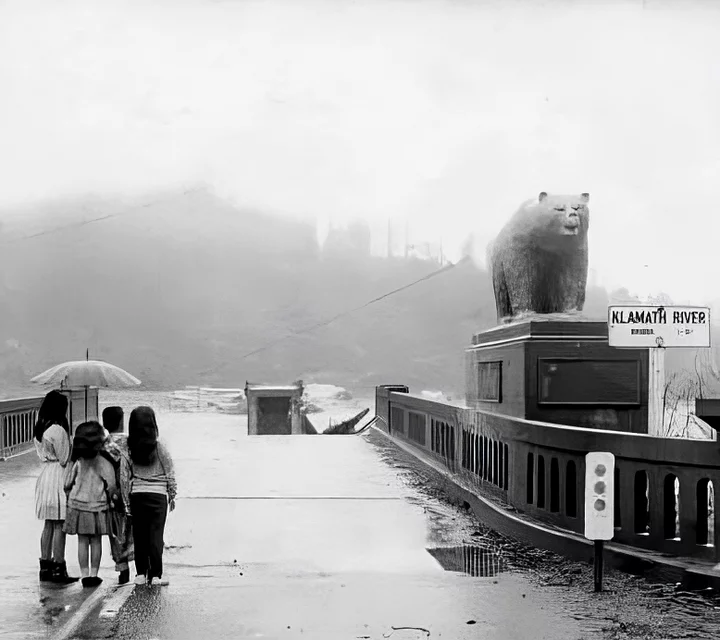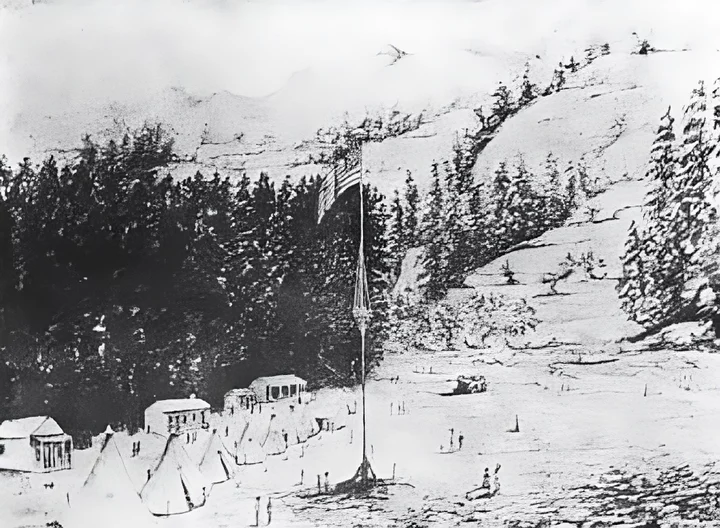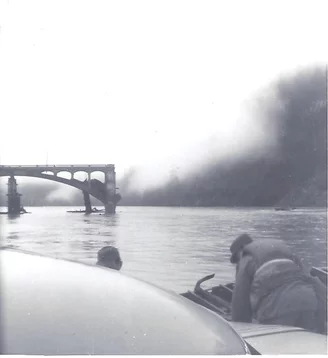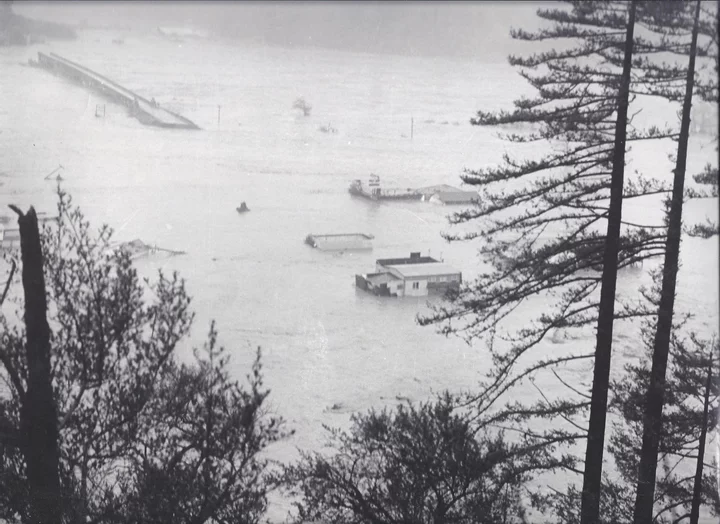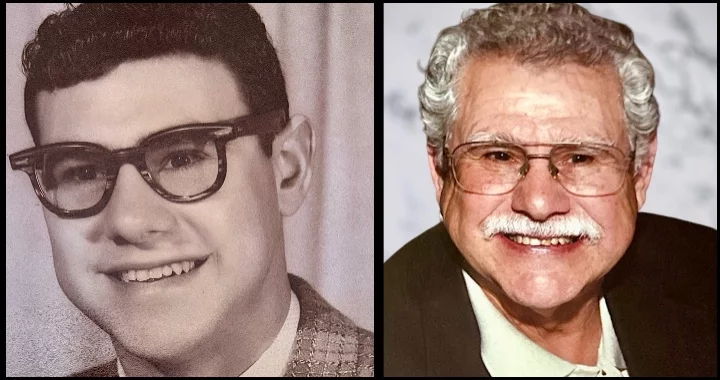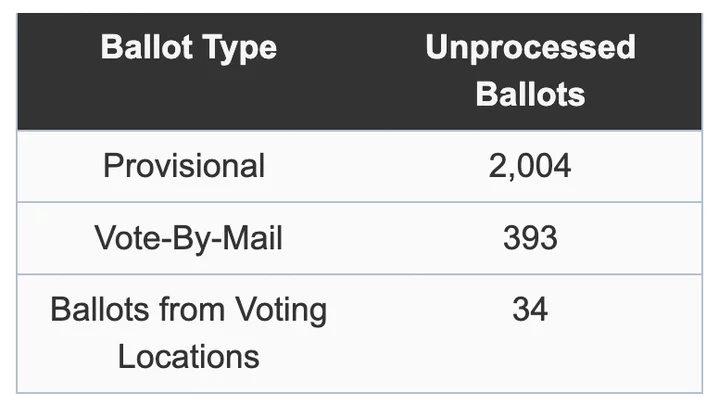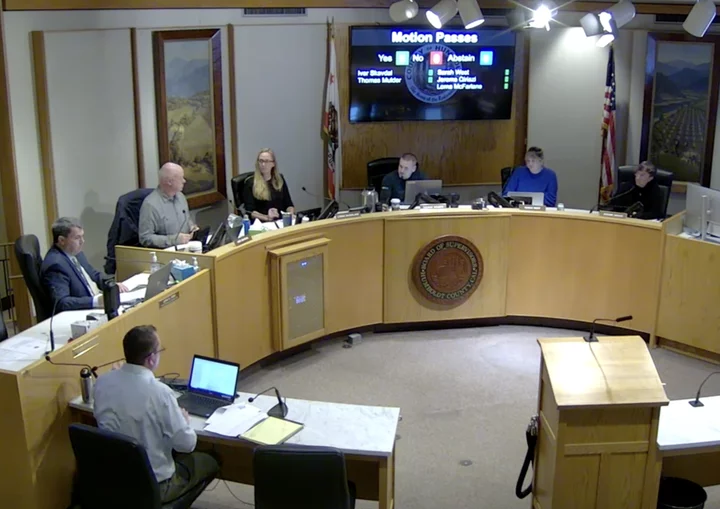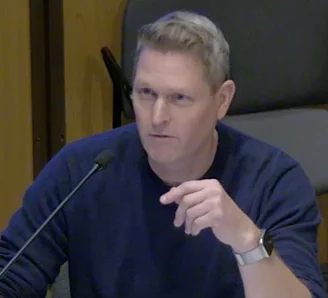(PHOTOS) YEE HAW! Cowboy Canned Food Convoy Returns to Old Town Eureka
Isabella Vanderheiden / Saturday, Nov. 23, 2024 @ 1:25 p.m. / Community , Feel Good , Food
Members of the local unit of the Backcountry Horsemen of California brought out their horses and mules on a rainy Saturday afternoon to collect canned goods for Food for People’s holiday food drive. | Photos: Isabella Vanderheiden
###
The Redwood Unit of the Backcountry Horsemen of California rode through Old Town Eureka on Saturday afternoon, collecting much-needed canned goods from local businesses for Food for People’s annual Cowboy Canned Food Convoy. The event kicks off the local food pantry’s annual Holiday Spirit Food & Fund Drive.
“The Cowboy Canned Food Convoy has been the kickoff for Food for People’s holiday food drives for years,” David Reed, Food for People’s Development Director, told the Outpost. “To me, it shows how taking care of our neighbors can be something we all take part in. This time of year, we’ve got everyone from high school students, businesses, our state senator, kids, families, and even cowboys and cowgirls collecting food and money to help make sure everyone has enough to eat.”
Since the COVID-19 pandemic, Food for People has seen a 30 percent uptick in people visiting the food pantry and seeking food assistance through the non-profit’s various nutrition programs, Reed said. Last year, Food for People served over 21,000 people countywide per month, “and the need is increasing.”
As is tradition, Food for People will team up with local high schools, state Senator Mike McGuire and our very own KHUM Radio for the food drive finale starting Dec. 9. You can donate canned goods and other non-perishable foods at local grocery stores and businesses around the county. Click here for a list of donation locations.
Last year’s holiday food drive “smashed” all previous records. Let’s make this year’s fundraiser one for the books, Humboldt!
###
BOOKED
Today: 2 felonies, 5 misdemeanors, 0 infractions
JUDGED
Humboldt County Superior Court Calendar: Today
CHP REPORTS
Patterson Rd / Bigfoot Ave (HM office): Traffic Hazard
ELSEWHERE
RHBB: Paving Work Scheduled Nov. 24–26 Between E Street and Spruce Street
RHBB: Reduce Food Waste This Holiday Season
RHBB: Coast Guard Rescuing Man Stranded 20–25 Feet Down Cliff in Shelter Cove
RHBB: Multiple Vehicles Strike Cows on U.S. 101 Near Cummings, South of Leggett
THE ECONEWS REPORT: Solar is Coming to Hydesville!
The EcoNews Report / Saturday, Nov. 23, 2024 @ 10 a.m. / Environment
Image: Stable Diffusion.
The Redwood Coast Energy Authority is working to encourage new local generation of renewable energy through their redesigned “Feed-In Tariff” program, which provides about-market pricing and a streamlined contracting process to encourage the development of local renewable energy projects. This means projects like the new solar farm near Hydesville, a project brought forward by renewable energy developer EDP Renewables.
Jocelyn Gwynn of Redwood Coast Energy Authority and Kendra Kallevig of EDP Renewables join the show to discuss the Feed-In Tariff program and how we can help foster the development of local renewable energy projects.
HUMBOLDT HISTORY: The 1964 Christmas Flood Wiped the Town of Klamath From the Map
Sherry Moore / Saturday, Nov. 23, 2024 @ 7:30 a.m. / History
McCovey children standing at the Klamath, looking over the lost Douglas Memorial Bridge.
###
The following is an excerpt from local author Sherry Moore’s new memoir The Raging Klamath: A Playground of Plenty, which is available right now at local bookstores — and lots of other places, too — throughout the region and would make the perfect Christmas gift for the Humboldt History buff in your life. Also on Amazon.
You can also pick up a copy and meet the author at the Humboldt County Main Library in Eureka on Saturday, Dec. 14, from noon to 3 p.m., when Moore will give a presentation and host a book-signing related to the memoir — a story of the river and the people who made their homes on its banks.
###
Chapter 16: The 1,000-Year Flood
The Christmas Flood of 1964 was the worst natural disaster to strike Oregon and Northern California in recorded history. The coastlines were especially hard hit. With sustained flooding from December 18 to January 7, one span of six days registered a total of 30 inches of rain, and a staggering 10,390,000-acre feet of water flowed into the Pacific Ocean from California’s northern tributaries. With the disasters of 1953 and 1955 considered to be 100-year flood, it was not a stretch to call this catastrophic event a 1,000 year flood.
Throughout its life, the Klamath River has always been vulnerable to annual changing weather patterns that cause the river to silt, flush and alter its flow. Before 1953, the most memorable floods on record occurred during the winter of 1861-62, in January 1881, in January of 1890, and the winter of 1926-27.
The flood of 1861-1862 impacted Washington, Oregon, Nevada, portions of Idaho, Utah, Arizona and California. It was the widest-spread, longest lasting, costliest, and harshest on the animals and people, as well as the erosion and lost buildings to California. At the time, there were only 350,000 people living in California, and the cost of rebuilding would bankrupt the state. Named the “Ark Flood” because it rained for 40 days and nights in parts of California. The storms began rolling into Oregon in November and then spread southeastward. Much like 1964, warm weather systems melted high snow packs, causing all streams and rivers to swell and overflow.
Along the coast, San Francisco recorded its highest amount of rainfall ever. Nothing has come close since. Thirty extra feet of muddy freshwater poured into the salt waters of the bay for days, bringing lots of fish for the taking. To the south, masses of snakes from the Sacramento Delta slithered onto farm fields at Monterey Bay. Cattle drowned by the thousands. San Diego’s topography was forever changed from eroding hillsides.
California’s inland valleys, as well as the Mojave Desert, became huge lakes that took several weeks to drain. Sacramento was so inundated that the capital was temporarily moved to San Francisco. Approximately one thousand Chinese immigrants, afraid to leave their cabins, were swept into the Yuba River and drowned. Active hydraulic gold mining operations compounded the erosion. In their book The Great Flood of 1862, authors W. Leonard Taylor and Robert Taylor wrote, “No single industry in the history of California has generated more long-term environmental damage for such a meager economic return.”
A severe two-year drought followed the 1862 flood. Many people suffered, due to a lack of food, shelter, and other necessities. Grasshoppers consumed the parched grasslands. With so much depletion and disappearing wildlife, starving Indians in the hills resorted to rustling cattle, and ignited a war with settlers. The magnitude of cattle lost forced an end to the large vaquero ranches.
From December to mid-January of that same winter, Terwer Valley experienced four episodes of the Klamath River cresting and ebbing. Ten to 15 feet of soil eroded away around Fort Terwer. All 20 of its buildings were lost, forcing most of the soldiers to live in tents. One of the officer’s tents, along with other wreckage included still-edible winter squash, washed up on Crescent City beaches. Nearly a century later, land surveyors found two partially-buried rock fireplaces from the fort at the east end of the Glen near the “Big Tree.”
The Waukell Indian Agency (Resighini Rancheria), was wiped out. Those who dwelt near the river lost homes and food-storage buildings. The narrow road into Terwer Valley was closed-off for several days, leaving Yurok canoes as the only mode of transportation up and down the river.
Sketch of Fort Terwer, via the Library of Congress.
With the Klamath Indian Reservation in shambles and the river still running high in March, government officials decided to abandon the fort and agency. Soldiers left Terwer for good on June 10, 1862. Thirty-nine of them escorted Indians to the new Smith River Reservation, 43 miles up the coast. Fort Lincoln was built between Crescent City and the Smith River to garrison the soldiers. The Yurok who stayed on the Klamath were glad to see the soldiers go, even though they got along with them.
The Smith River Reservation continued to grow, with several hundred more displaced Indians coming in from Humboldt County, significantly reducing the Eel River and Redwood Creek Indian populations. Some escaped into the hills, or went back to where they once lived and adapted to the white man’s culture. Indian agent Morgan Tucker, who spoke several Native American languages, stayed at Requa with a couple of soldiers to keep peace for many years.
In 1863, William H. Brewer, a professor of agriculture, visited Klamath and Crescent City. He was amazed at the assortment of trees that had come down the Klamath River and were washed up along the coastline. “They were tremendous in size and length,” he reported. “The eight-mile beach at Crescent City was covered to a width of 200 yards and a depth three to eight feet with debris. There was enough wood on the beaches to supply the timber market for years.”
The next major flood for Klamath happened in January of 1881. According to Morgan Tucker the depth of water was higher than that of 1862 and his experience was similar. Enormous uprooted trees came crashing down the river, homes were lost, and livestock drowned. Upriver, 100 miners from Sawyer Bar on the Salmon River were washed out, and, with no provisions, were soon starving. They made it to Little Ike Camp, a Karuk village on the Klamath River, where they were generously fed dried salmon, deer meat and acorn soup before being supplied with enough provisions to go back to Orleans.
Nine years later, in 1890, another great flood struck. Hunter Creek, a small tributary close to the mouth of the Klamath, was 10 feet deep in some places. At Martin Ferry Bridge, 40 miles upriver, the Klamath rose 100 feet, and carried away the local suspension bridge. The oldest resident there said this was the highest level in his lifetime. His observation is reinforced by Terwer records showing the river crested three feet higher than in 1862.
Fellow friend and woodsman Stacey Fisher, who grew up in Hunter Creek, offered this perspective:
I noticed a large spruce tree at Hunter Creek that had a flood ring around it. The ring was 15 feet above its bottom base. The old-timers said it was from one of the late floods of the 1800s. The 1964 flood didn’t come close. Before the 1964 flood, a couple of loggers were walking in some alders at Starwein Flat on the Klamath River. One logger stumbled over the top of a redwood tree sticking out of the ground. I was called in to dig out what turned out to be a huge old-growth redwood. This tree had been buried for many years from one of the early floods. Some of the outside was rotted, but the tree was basically sound. I dug down over six feet and bucked it up. Three timber-transport truck loads were hauled out.
For the following 37 years, flooding on the Klamath was unremarkable. However, in 1927 flood waters crested just two feet lower than what we would experience in 1953. The new town of Klamath was rapidly taking shape and had a lot of recovery work to do after about three feet of water consumed it. That flood damaged or destroyed all it touched, including Dad’s family restaurant. Small cabins, barns, and fencing went down the river, which stayed high from December to March.
The gravel from under the newly built Douglas Bridge was carried by powerful currents to the sandy islands at the mouth of the Klamath. Safford Island (Bear Island) was heavily eroded. Named for a local fisherman and his family, the island was a popular summertime destination, with cabins and docks. Visitors enjoyed rowing in from the mainland to picnic and fish. A large open field was perfect for pick-up baseball games. Even cows swam over to graze on the thick grass. Occasionally, platforms were erected with lights and a live band for dancing. Indian also performed ceremonial dances. Longtime local resident Mary Larson Wakeman remembered the island this way:
The Charles Gibbon family lived and farmed on the island. They had a nice garden and orchard. Sweet peas and cherries were a favorite. Sometimes neighbor kids, including my dad and his brother, paddled over to the island and played with their kids, showing up for a meal. With 16 children I don’t think their parents even noticed them at the dinner table. Wildlife like deer and bear frequented the island and still do today.
About 15 feet off of the Klamath Glen Road, just before it turned up the hill near McBeth’s, there was an old-growth redwood tree that I estimated to be about 150 years old in 1964. About 18 feet up from the ground, there was a four-inch band of chocolate-colored silt embedded in the bark. The 1964 flood had only come close to its base, so I often thought maybe the river had earlier flowed high on this north side, before changing course to now flow on the south side. Another scenario was that an avalanche had come down the hillside and created a dam near this tree, backing up the water. Without a lot more scientific study and analysis, one couldn’t tell if this was the flood of 1862, 1881, 1890, or another flood before the white settlers came. Regardless, it was a remarkable and perplexing sight.
###
Thirty-four California counties were declared a disaster area in 1964. President Lyndon Johnson designated Northern California a natural disaster area. Californian Governor Pat Brown declared a state of emergency. The US Dept. of Civil Defense, along with the county supervisors and local government agencies had their hands full rendering assistance and aid. Among those counties that suffered the most were Del Norte, Humboldt, Siskiyou, Mendocino, Trinity and Sonoma. Besides the Klamath, some of the other area rivers recording record-breaking heights were the Smith, Trinity, Van Duzen, Mad, and Eel, which crested at mind-boggling 46 feet. Today, travelers on Highway 101 near Miranda have to look well above their heads to see the marker memorializing this measure of a 1,000 year flood. However, the Mad River was two inches below the 1955 flood, because the new spillway at Ruth Lake Dam, despite overflowing and eroding, held back a sizeable amount.
In addition to the town of Klamath, other communities wiped out were Alton, Metropolitan, Holmes, Shively, Pepperwood, and Ti-Bar. Local areas that suffered major damage included Crescent City, Gasquet, Smith River, Orick, Fernbridge, Hoopa, Weitchpec and Orleans. In Oregon and Northern California, a total of 47 people lost their lives, mainly due to drowning, mudslides and helicopter crashes. Three deaths occurred on the Klamath. One was a drowning, a second was due to overexertion, and the third occurred when a Red Cross worker was struck by a helicopter blade at Happy Camp while loading supplies. Within the state of California alone, nearly 2,000 people suffered injuries.
In one way or another, everyone in the disaster zone was impacted. About 5,000 homes, 400 businesses and 1,100 farm buildings were destroyed or heavily damaged. Close to 7,900 families suffered losses in Humboldt and Del Norte counties, alone. Over 8,400 head of livestock, nearly half of them cattle, drowned. Several thousand acres of agriculture land was ruined.
Transportation and general services including utilities, public safety, and road maintenance were crippled. Eighty percent of county roads suffered significant damage, and 16 major bridges washed out. Several sections of Interstate 5 from Washington down to Northern California were closed for a week or more.
The iconic Fernbridge over the Eel River in central Humboldt County was saved by men working day and night removing jammed debris from under the structure with a crane. Further south, when logs began lodging up against another bridge near Scotia, a brave soul ventured onto the pileup with a box of dynamite, and blew it apart. Other bridges were not so lucky, and residents made use of a networks of backroad to get from one place to another. Thankfully, Orick’s Kane Bridge and the Mad River Bridge north of Arcata held, making 101 drivable from the washed-out Douglas Bridge to Eureka. With road and railroad transportation impaired, larger communities like Arcata and Eureka that were outside the flood zone also suffered. Badly-needed supplies were brought in by ocean barges and airplanes.
Highway 299 from Arcata to Redding was closed in many areas, forcing travelers to detour on unpaved backroads. Highway 96 was among the most damaged. From Willow Creek to Yreka, large sections of road and several bridges on the Trinity and Klamath rivers were gone, isolating Hoopa, Orleans, Happy Camp, and several Indian villages.
One-third of Highway 169 from the upper Klamath to Johnson had disappeared. Helicopters and boats were dispatched for emergency situations and supply drops, and gas was rationed. This area suffered the most, and remained isolated for quite some time.
In Del Norte County, the greatest roadway loss was the Klamath Bridge. The Dr. Fine Bridge on the lower Smith River and the Chetco River Bridge miraculously survived, which kept Highway 101 open from Klamath to Crescent City and on to Brookings, Oregon. Highway 199, from Crescent City to Grants Pass, Oregon, endured the loss of three major bridges. Slides in the Smith River gorge were huge, and wiped out several miles of road. It would take months of repair work to open this route.
Bridge damage in the Klamath-Trinity drainage area was unbelievable. Upper Klamath residents reported seeing 100-foot high piles of debris flowing by. The bridge at Willow Creek connecting Route 96 with 299 was completely destroyed. In the Weitchpec-Orleans-Somes Bar vicinity, every bridge was taken out, including the beautiful, prized-winning suspension bridge at Orleans, and the little jeweled-like US Forest Service suspension bridge at Ishi-Pishi. The Martin’s Ferry bridge broke apart in water flowing 115 feet deep.
An eyewitness recalled watching the Douglas Bridge on the lower Klamath give way:
Before the structure failed, debris was backed upstream several hundred feet, although the river level was several feet from the top of the arches. At times, small logs would come hurtling downstream, hit the floating debris, and shoot into the air completely over the structure. The pressure of the river, against the debris, finally pushed 400 feet of the bridge out of the way, and the debris shot downstream with a roar. Another 200 feet of the bridge was left in shambles.
Due to impassable transportation routes and the loss of several thousand jobs, the logging and lumber industry faced a number of challenges. The main source of employment for coastal communities, California was the second largest lumber producer in the U.S. Before the flood, ninety percent of all lumber products were transported by the Pacific North Coast Railroad. Three rail bridges were out, along with 30 miles of uprooted and twisted rail. Some 70 pieces of rolling stock (cars) were either destroyed or missing. It would take 177 days to fully reopen the railroad between Humboldt County and San Francisco. With so much damage to transportation infrastructure, the state had to draw on funding appropriated for Southern California to hire contractors and cover the cost of rebuilding.
Mills shut down or remained in only partial operation for several months. Just getting into the woods to fall timber was difficult, because roads were perilous and weather conditions bad. Millions of board feet of logs and lumber went down the rivers and ended up on beaches and in harbors. Mills that lost timber in the 1955 flood had raised their log and lumber stockpiles at least five feet higher, but that precaution didn’t matter with this flood. Logs weighing 30 tons each were lifted from their resting place and swept downriver like missiles. Hundreds of millions of board feet of timber were lost. The Pacific Lumber Company estimated their loss to be 23,000,000 board feet in lumber alone, plus 18,000,000 in logs.
Well before waters shrank back into their natural banks, help arrived from all over the country. Every branch of the US military was involved, especially the Army Corps of Engineers. Construction workers dropped jobs in other regions to work in flood-stricken areas. San Quentin Prison sent 4,000 inmate workers. Many non-profit organizations in and outside the region contributed greatly, especially the Red Cross and Salvation Army. Those small airports not destroyed were bustling with personnel, vehicles, helicopters and planes rescuing stranded people and delivering supplies such as medicine, food and water. With grasslands layered in silt, and with much hay lost, animals also needed food and medical support. The USDA flew in free grain, and tons of hay. Planes came from as far away as Georgia to assist. Local airports like McNamara Field in Crescent City, Rohnerville Airport in Fortuna, Murray Field in Eureka, and Arcata Airport in McKinleyville were like beehives.
Local people who owned aircraft volunteered assistance. One of them, Les Pierce, told me how he risked life and limb rescuing people and making deliveries in a small helicopter. He recalled flying low in the most dangerous and stormy conditions imaginable, often with no sleep. Once, it was so cold his hand nearly froze to the cyclic stick.
Les, along with all of the other courageous volunteers, should never be forgotten. They operated in virtual war zone, working against Mother Nature to move people out of harm’s way. Small planes even landed on highways to pick up stranded people unable to drive in either direction.
My classmate Dean Hupp, whose parents Aileen and Chuck co-owned Panther Creek Lodge, recalled how his family had left the day before to spend Christmas with relatives in Los Angeles. They got stranded by severe weather in the small town of Garberville in southern Humboldt County. Three days later, they were able to catch a private plane back to Del Norte County. When they were finally able to get to the lodge, little was left. The Hupps and DeVols, two young couples who had pooled their life savings to run a vacation and fishing lodge, were forced to give up on that dream.
Although severely eroded, the Iron Gate Dam spillway on the upper Klamath held, but its powerhouse was submerged, resulting in a lengthy shut down. Every regional dam was near peak flow. The new Trinity and Lewiston dams on the Trinity River managed to hold back a sizable amount of water, and reduced some flooding below. The Trinity River did not break the 1955 flood records because of the 372,200 acre-feet of runoff stored behind the dams. Nonetheless, an impressive 231,000 cubic feet of rushing water per second was calculated at Hoopa. The Klamath reached flows of 557,000 cubic feet per second, and submerged the town of Klamath under 15 feet of water.
Town of Klamath. Photo: James Yarbrough.
At Weitchpec, the water level was 13.7 feet higher than the 1861-62 flood, and 19.5 feet higher than the 1955 flood. Much of this huge increase in height was believed to have been caused by an immense surge in the Salmon River. A massive 2-3-million-cubic-yard landslide six miles up the Salmon dammed the river, then let loose, suddenly amplifying the already-disastrous flows of the Klamath, Trinity, and Scott rivers. According to California High Water 1964-65, published in 1966 by the California Dept. of Water Resources, the North Coast region experienced $190 million in damages — $71 million in the Eel River Valley and close to that in the Klamath River Basin. However, upon further study and evaluation, the overall total cost was later estimated to be $450 million, or the equivalent of $3,510,000,000 today.
Where I lived on the lower Klamath, our community was extremely grateful to have not lost a single life in the 1,000-year flood of 1964. However, the loss of property, jobs, businesses, and, truth be told, our very way of life, created unimaginable hardship. Klamath, Del Norte County’s second largest town with a population of 850, had been erased from the landscape. Three hundred houses, every downtown business, and our beloved bridge had been swept away, with nothing left in town but a few skeletal remains of buildings surrounded by gaping holes. The Terwer-Klamath Glen area, with a population of 1.000, experienced similar destruction. Many of the radar base families also lost their homes. Major Cavalli, commandant of the 777th Radar Air Force Base, immediately arranged for 20 mobile homes to be hauled from Malmstrom Air Force Base in Montana to Klamath. Additional government trailers were brought in for other flood victims, and parked wherever they could find a decent spot — whether a trailer park, a piece of property donated by a generous owner, or, as in my family case, next to the house we would put back together piece by piece.
###
You like history? Consider a subscription to the Humboldt Historian, a journal of the Humboldt County Historical Society. The Humboldt County Historical Society is a nonprofit organization devoted to archiving, preserving and sharing Humboldt County’s rich history. You can become a member and receive a year’s worth of new issues of The Humboldt Historian at this link.
OBITUARY: Vicki Kay Cooper, 1942-2024
LoCO Staff / Saturday, Nov. 23, 2024 @ 6:56 a.m. / Obits
Vicki Kay Cooper passed away peacefully on the morning of October 16,
2024 with her cherished daughters by her side. Our beloved mother,
grandmother (Grammoo), great grandmother (MoMo), sister, Aunt and
friend had just recently celebrated her 82nd birthday. Vicki was born
September 26, 1942 in Ogden, Utah to Frank Shone and Beverly Newren.
Vicki met the love of her life, her eternal companion, Donald George Cooper at Clear Lake while water skiing. That fall, by chance they met again at Brigham Young University at a back to school dance. Don and Vicki were married when Vicki was only 19. They moved to McKinleyville in 1961 where it became their lifelong home.
Vicki’s first passion was being a mother. Her family meant the world to her. She always dressed her girls in matching outfits with perfect matching bows and never a hair out of place. She supported them through their lives in all their sporting events, dance recitals, even being a cheerleading coach, Blue Birds leader, summer camp leader, all the summer activities at the lake, teaching her girls to waterski at age 3, school shopping, helping write our english essays, and so much more. Love, grace, elegance, beauty, zebra, leopard, glitter & high heels best describe Vicki.
Vicki had a passion for her career in real estate and anyone that had the privilege of being one of her many clients through the years knew that she cared for each of them. Vicki started selling real estate in the early 80’s and found her permanent home with Sue Forbes and Forbes & Associates until 2006 when she retired. Each year instead of sending out “boring” Christmas letters to her clients, she (Cami) would deliver a gift to each of her many clients to their doorsteps. This was a great reminder that she was passionate about her job and wanted her clients to know how much they were appreciated.
Vicki had a talent for transforming any space into a beautiful, welcoming home. Vicki’s decorating skills brought joy to all her family and friends, but nothing compared to her enchanting displays at Christmas. She loved to decorate for every holiday, but Christmas at Vicki’s was a magical, winter onderland. Noone would argue that Vicki’s house at Christmas was spectacular with every room (even the bathrooms) decorated with her beautiful Gold Santas and sparkling ornaments. There was no space unfilled with her life size santas and beautiful decorations. Gold, glitter, lace & nutcrackers filled Vicki’s home with beauty at the holidays.
Vicki was born and raised a member of The Church of Jesus Christ of Latter Day Saints, took great pride in its history and gave freely to many years of service with youth and adults. Vicki had a strong testimony of the gospel of Jesus Christ and took any opportunity she had to share it with you. Vicki was famous for leaving subtle messages on the back of the toilet seat (an open article to something that needed to be read by her kids or grandkids). Vicki knew that Families are Forever and she found comfort knowing that she would be reunited with her loved ones again. Charitable, giving, successful, loving and compassionate is how Vicki will be remembered.
Vicki loved to travel. She and Don went many places through their 49 years of marriage. Vicki’s favorites were Hawaii and Mexico. Vicki loved the sun. She would sun bathe until the sun went down. She loved to have a tan. She would say,”my tan skin makes me feel human”. “It’s me!”
Vicki is survived by her greatest joys in her life, her daughters Julie Cooper, Joni Riojas(Hector Riojas) Cami Cooper Claros (Eddie Claros) Grandchildren Jaime Johnson, Kyle Cooper, Preston Johnson, Tyler Cooper, Kelby Cooper, Alexandra Claros Shepherd (Joseph Shepherd)Tor Claros and Kalyssa Claros. Great Grandkids Donovan Cooper and Tatyana Cooper. Her “adopted” daughter Joann Garber, Grandkids Carissia Andersen and Cailin Olsen. Great Grandkids Adley Pedrotti, Jianna and Coyer Andersen. Vicki is also survived by her brother Fred Butler.
Vicki is preceded in death by her husband Donald George Cooper, father Frank Shone, mother Beverly Jean Billings, Brother Frank Shone Butler and grandson Tyson Eduardo Claros.
A graveside service will be held on December 28, 2024 at Oceanview Cemetery for family and friends at 11 a.m. 3975 Broadway, Eureka Celebration from 2-5 at 2400 Mather Road, McKinleyville, CA 95519.
###
The obituary above was submitted on behalf of Vicki Cooper’s loved ones. The Lost Coast Outpost runs obituaries of Humboldt County residents at no charge. See guidelines here. Email news@lostcoastoutpost.com.
OBITUARY: Clyde Richard Terry, Jr., 1938-2024
LoCO Staff / Saturday, Nov. 23, 2024 @ 6:56 a.m. / Obits
It is with great sadness that we announce the passing of Clyde Richard Terry, Jr., a lifelong resident of Humboldt County. During the very stormy month of February in 1938, he was born in Eureka. Clyde died on October 26, 2024 at his Eureka home surrounded by his family as he wished. Clyde’s parents, Clyde Sr. and Elizabeth, joked that his birth was very expensive since the weather only permitted his dad to work three days that month: the day his mom went into labor forcing her to take a taxi to the hospital, the day Clyde Jr. was delivered, and once again a taxi ride to bring Clyde Jr. and Elizabeth home from the hospital. His father joked Clyde’s birth cost double his wages for the month.
During Clyde’s 86 years he was a beloved baby brother, uncle, husband, girls’ dad, grandfather and great grandfather. Chances are if you shopped for groceries in Eureka or Arcata between 1954 and 1995, you were waited on by Clyde, the smiling grocer with the dark curly hair. People asked for his help in stores even after he retired.
Clyde loved animals which was fortunate since he put up with caring for horses for almost 40 years so his daughters and oldest grandson could each have a horse. He lost the last mare when his youngest grandson was 2 months old so he decided to share golf with Rique and insisted on buying his great-grandson, Donny, a junior set of golf clubs so they could play miniature golf. The cost was probably the same, but the upkeep was considerably easier. Clyde liked to keep busy in his retirement. He decided to turn the horse pasture into a park which gave him an excuse to buy tractors and tools. The park allowed his beloved dogs & grand dogs a wonderful place to roam and an excellent place for his great grandson to practice baseball. Clyde loved to play golf. One day at the Muni, a doe decided to climb into the golf cart with Clyde to share his banana. Clyde enjoyed sharing his 5 acres with the deer, even if they did eat more apples than he did.
It is with great gratitude that Clyde’s family will remember him. He was fiercely proud of his children, grandchildren and great grandson. His wife was very proud of him for saving the lives of three swimmers, a mother and daughter in our local river and a young boy in a motel pool.
Clyde is survived by his wife of 64 years, Josephine McBeth Terry; his two daughters Lela Razo (Sam) and Sheila Rhodes (Rob Lane); his two grandsons Allen Terry (Rachel) and Rique Razo; his great grandson, Donny Terry; his brother Eugene Terry (Katie); and his sister-in-law Judy George (Rick); as well as many nieces and nephews and cousins. He was preceded in death by his brother, Edward (Imogene); and his sister, Laura Schlenker (Louis); his parents Clyde Sr. and Elizabeth; and his in-laws Harold and Arkisi McBeth. He lost his neighbor and good friend, Michael Griffith, shortly before he passed.
The family wishes to extend special thanks to Dr. Shahram Abbassi, Dr. Tony Anagnostou, John and Rob McBeth, Sam and Rique Razo, Allen Terry, Jacob Woody, Rob Lane, Sophia from Home Health and our plumber, Isaac Kennedy.
Clyde wanted a celebration, not sadness!
Please join us for a celebration of life open house on Sunday, December 8th at Rob and Debbie McBeth’s Barn, 1123 Freshwater Road, Eureka, from 1-4 pm.
###
The obituary above was submitted on behalf of Clyde Terry Jr.’s loved ones. The Lost Coast Outpost runs obituaries of Humboldt County residents at no charge. See guidelines here. Email news@lostcoastoutpost.com.
VOTE COUNT UPDATE: Blue Lake City Council Race Still Undecided
Ryan Burns / Friday, Nov. 22, 2024 @ 5:06 p.m. / Elections
Humboldt County Supervisor Rex Bohn (left) poses with Registrar of Voters Juan Pablo Cervantes on Election Day. | Photo via the Elections Office Facebook page.
###
PREVIOUSLY:
###
With just over 2,400 ballots yet to be counted from across the county, things remain pretty much unchanged since last week, when we noted that only the race for three open seats on the Blue Lake City Council remains undecided.
Challengers Michelle Lewis-Lusso remains the top vote-getter among the seven candidates, followed by John Sawatzky, whose vote count stands at 249 with this latest update. Right behind him are incumbent Mayor Adelene Jones and challenger Kat Napier, both of whom, remarkably, have received exactly 243 votes.
Incumbent Christopher Guy Firor is theoretically within striking distance with 232 votes.
It’s impossible to say how many of the remaining 2,431 uncounted ballots were cast by Blue Lake residents. Regardless, this nail-biter will drag out for at least another week.
Up in Arcata, Alex Stillman remains ahead of challenger Genevieve Serna — with 3,221 votes to Serna’s 2,781 — all but cementing her victory for re-election alongside fellow incumbents Stacy Atkins-Salazar and Sarah Schaefer.
The “no” vote on Measure F remains just a hair below 70 percent. That thing got pummeled.
Click the link below for the full list of updated results.
###
Here’s the press release:
The Humboldt County Elections Office has released its third post-election results update following Election Day.
The Elections Office has approximately 2,431 unprocessed ballots as of today, Friday, Nov. 22.
All valid vote-by-mail ballots will be counted regardless of the outcome or closeness of any race if they were postmarked by Tuesday, Nov. 5 and were received by Tuesday, Nov. 12. The Humboldt County Office of Elections will continue to post the results of the Nov. 5, 2024 General Election every Friday by 5 p.m. leading up to the certification of the election prior to Tuesday, Dec. 3.
For more information on the results of the election, please visit the Elections Results webpage or call 707-445-7481.
Humboldt Planning Commission Approves Contentious Weed Farm Near Garberville, Despite Claims That Cannabis is No Longer Legal in California
Isabella Vanderheiden / Friday, Nov. 22, 2024 @ 4:36 p.m. / Cannabis , Local Government
Screenshot of Thursday’s Humboldt County Planning Commission meeting.
###
The Humboldt County Planning Commission on Thursday unanimously approved conditional use permits for The Hills, LLC and Shadow Light Ranch, LLC – a controversial cannabis operation located in the hills just east of Garberville – despite objections from neighbors and some members of the public who believe the project violates state and federal law.
The commission voted 5-0 in favor of the project, with Third District Commissioner Noah Levy and Fifth District Commissioner Peggy O’Neill absent.
The project application, submitted by Garberville resident Joshua Sweet in 2016, includes 60,940 square feet of existing cannabis cultivation (50,940 square feet of outdoor and 10,000 square feet of mixed-light cultivation), a proposed 10,080 square-foot wholesale nursery to support on-site operations, a 13,472-square-foot processing facility and roughly 5,184 square feet for employee housing.
The proposed project also includes the decommissioning and restoration of three unpermitted ponds that were at the center of a legal dispute with the California Water Boards and California Department of Fish and Wildlife (CDFW). Earlier this year, Sweet agreed to pay $1.75 million – $500,000 to the Division of Water Rights, $175,000 to the North Coast Water Board, $75,000 to CDFW and another $1 million for remediation work – for “diverting water from illegal onstream reservoirs without first obtaining permits required” through the state.
At Thursday night’s meeting, Sweet reassured commissioners that the state-mandated mitigation measures “are already in play,” adding that the three ponds are “no longer there.”
“We’ve been in negotiations with the water board for … eight years now [and] an enormous amount of work has gone into this,” he said. “There is some wetland restoration program that has to happen in the next two years, but other than that it is resolved. There’s a few culverts that have to go in as well, but pretty much 90 percent of it is taken care of and 100 percent of it is negotiated and done. So there’s no more need to hash out anything between the agencies and myself, I feel like we’re getting along now and things should be moving forward smoothly.”
Even so, the cannabis cultivation project has drawn criticism from some residents along Wallan Road, a primary access point to the 560-acre property, who worry about increased traffic along the narrow county road.
“[T]he biggest concern is the use of Wallan Rd as an access,” according to a letter submitted by Agnes and David Patak. “There are places on the road where it’s beyond potholes and no matter how many times you fill them they don’t last and just become worse. It is only a one lane road and cannot handle anymore traffic. They propose to build housing which takes big trucks to deliver the supplies. THIS IS NOT A COMMERCIAL ROAD FOR COMMERCIAL USE!!!”
County staff convened a neighborhood meeting at the end of last month to discuss the project with folks living near the project site. As expected, the conversation centered around traffic impacts on Wallan Road.
“[It] is a county-maintained road and has nothing to do with me,” Sweet said. “During that public meeting, I point-blank asked everyone ‘Do any of you know which cars are associated with my project or not?’ and not one person could say. So, basically, they were unaware of … who was doing what and when. I had already implemented the program to send heavy equipment [and] delivery trucks … around the back road, so the traffic that they’re talking about is not me. It’s an accumulation of 45 different parcels, five cannabis companies and four heavy equipment operator companies.”
During the discussion, Planning Manager Cliff Johnson acknowledged the recent appellate court ruling that determined cannabis is illegal in California “because federal law says so.” The shocking determination emerged from a lawsuit – JCCrandall LLC v. County of Santa Barbara – over the legality of transporting an illegal product on a private easement without explicit permission from the property owner.
“It’s the county’s position that that court case is not applicable to the situation in Humboldt County,” Johnson said. “[Santa Barbara] County’s land use development code requires that the county must find that the streets and highways are adequate and properly designed to carry the type and quantity of traffic generated by the proposed use. … That’s a different situation than what occurs in Humboldt County.”
All three speakers who spoke during the public comment portion of Thursday’s hearing brought up the recent state appellate court decision and asserted that the Planning Commission would be breaking the law if it approved the permit.
“You cannot approve a conditional use permit for cannabis – particularly to transport cannabis – because by approving this permit without consent [of neighboring landowners], you are forcing [them] to violate a federal law,” said one commenter, who did not identify herself. “And in that case, the court clearly says that cannabis is illegal under federal law … regardless [of] what California wants to believe. … This is the law of the land right now [in] California, and in the Supremacy Clause that’s all that counts.”
Another commenter, who did not identify himself, noted that the county’s position on the easement issue “is clearly at odds with the decision made by the appellate court” and, like the previous speaker, urged the Planning Commission to deny the project.
“It doesn’t really matter what ordinance – or any other doctrine or document – that the county has talking about easements; it cannot trump the federal law,” he said. “If the commission chooses to thumb its nose at this decision, it’s going to be on record and it’s going to come back to bite the county later on … and I don’t think the taxpayers really want to be putting up more money to fight legal situations that could have been averted by a simple Planning Commission decision saying, ‘Hey, look, this isn’t right.’”
Appearing via Zoom, Deputy County Counsel Joel Campbell-Blair said the county is still trying to figure out “what it all means,” given that the ruling was issued less than a month ago and is being appealed by the County of Santa Barbara.
“When the state issues permits, it doesn’t apply to us and, therefore … it doesn’t have the force of law,” Campbell-Blair explained. “The state has not stopped issuing permits. They don’t feel like that applies to them either. We’ll kind of see where it goes … but I would just maybe warn or caution everybody not to over-apply the case. You know, when judges make law, they make law only as to the issue that was right before them, and that was [the case with] the Santa Barbara County code provision.”
Commission Chair Thomas Mulder asked about transporting cannabis on forest service roads, which are federally maintained. “I do recall that there are some projects out there we’ve approved that use forest service roads, and there’s a direct comment from the U.S. Forest Service if memory serves, that says it’s federally illegal and they don’t support it,” Mulder said. “This isn’t the first time federal illegality has been referenced in regards to accessing a project, is that correct?”
Early in the statewide permitting process, Planning and Building Director John Ford said the county adopted a policy that it would not “approv[e] the use of the road” for cannabis transport. Instead, the property owner would be responsible for “taking the risk.”
Fourth District Commissioner Jerome Qiriazi noted that the Planning Commission is “not approving [the] transport of cannabis, we’re approving production.”
At-Large Commissioner Sarah West acknowledged concerns raised during public comment but emphasized that she and other commissioners are not lawyers and, as such, rely on county counsel’s legal expertise. “They are the expert in this situation … so I will be depending on them for their legal interpretation.”
After a bit of additional discussion, First District Commissioner Iver Skavdal made a motion to approve the project and associated permits. Qiriazi offered a second but asked to amend the motion to correct a couple of small inaccuracies in the mitigated negative declaration (MND) for indigenous artifacts. Skavdal agreed and the motion was approved 5-0.
###

